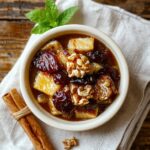I’ve been making whipped cream from scratch for years, and there’s something magical about transforming simple heavy cream into silky, cloud-like perfection. Most people think it’s complicated or time-consuming, but I’m about to share the technique that’ll change everything you thought you knew about this essential dessert topping. The secret isn’t what you’d expect, and once you master this method, you’ll never buy store-bought again.
Whipped Cream Recipe

I can tell you with absolute certainty that once you make homemade whipped cream, you’ll never go back to the store-bought stuff again. There’s something almost magical about watching heavy cream transform from liquid to fluffy, cloud-like perfection in just a few minutes, and the taste difference is night and day—rich, silky, and naturally sweet without any of those artificial stabilizers or preservatives.
I’ve been making whipped cream this way for years, ever since my grandmother taught me her foolproof technique, and I’ve tweaked it to perfection through countless dinner parties, holiday desserts, and late-night baking sessions. The secret lies in using the coldest cream possible and knowing exactly when to stop whipping—you want those gorgeous, soft peaks that hold their shape but still have that luxurious, melt-in-your-mouth texture that makes everything from fresh strawberries to chocolate cake taste like a five-star dessert.
This recipe is so simple that you probably already have everything you need in your kitchen right now, and in less than five minutes, you’ll have fresh whipped cream that’s infinitely better than anything you can buy in a container.
Ingredients

Making perfect whipped cream comes down to just a few simple ingredients, but here’s the insider secret: quality matters more than quantity. The temperature of your cream and the freshness of your ingredients will make or break this recipe. Don’t worry if you don’t have every fancy tool—I’ll show you exactly what you need and smart swaps that work just as well.
- Heavy whipping cream (1 cup) – This is your non-negotiable base! Must contain at least 35% fat content or it simply won’t whip. Heavy cream creates those gorgeous, stable peaks that hold their shape. Don’t even think about substituting regular milk here.
- Powdered sugar (2-3 tablespoons) – Way better than granulated sugar because it dissolves instantly and won’t leave you with gritty texture. Plus, the cornstarch in powdered sugar acts as a natural stabilizer. No powdered sugar? Pulse granulated sugar in a blender for 30 seconds.
- Pure vanilla extract (1 teaspoon) – Real vanilla extract is worth every penny for that rich, complex flavor. Skip the imitation stuff—it tastes flat and artificial. In a pinch, vanilla bean paste works beautifully and adds those gorgeous black specks.
- Pinch of salt – This is my secret weapon! Just a tiny pinch enhances all the flavors and makes the sweetness pop. Trust me on this one.
- Optional flavor boosters – A tablespoon of cocoa powder for chocolate whipped cream, or a teaspoon of instant coffee for mocha magic. Fresh citrus zest transforms it into something bakery-level special!
How to Make the Best Whipped Cream

- Chill your bowl and beaters for at least 15 minutes before starting.
Cold equipment is your secret weapon for perfectly whipped cream. Pop your mixing bowl and beaters (or whisk attachments) into the freezer while you gather your ingredients. This temperature boost helps the cream whip faster and hold its peaks longer. Skip this step and you’ll be whipping forever with disappointing results.
- Pour cold heavy cream into your chilled bowl.
Use heavy cream with at least 35% fat content – anything less won’t whip properly. The cream should be straight from the refrigerator, not room temperature. Start with less cream than you think you need; it doubles in volume once whipped, so a little goes a long way.
- Begin beating on medium speed until the cream starts to thicken.
Resist the urge to blast it on high speed right away. Starting slowly prevents splattering and gives you better control over the process. You’ll notice the cream becoming slightly foamy and coating the beaters after about 30-60 seconds. This gradual approach prevents the cream from separating later.
- Increase to medium-high speed and watch for soft peaks to form.
Soft peaks bend over when you lift the beaters – they hold their shape but still droop gracefully. This usually takes 1-2 minutes once you increase the speed. These peaks are perfect for folding into other desserts or creating a light, airy texture in parfaits.
- Add sugar and vanilla extract once soft peaks form.
Adding sweeteners too early can interfere with the whipping process, so wait for this stage. Pour in powdered sugar (which dissolves more easily than granulated) and pure vanilla extract. A tablespoon of sugar per cup of cream is a good starting point, but taste and adjust to your preference.
- Continue beating until you reach your desired consistency.
For medium peaks that hold their shape but still have some give, beat for another 30-60 seconds. For stiff peaks that stand straight up, continue for another minute. Watch carefully during this stage – there’s a fine line between perfect whipped cream and butter. Stop the moment you see the peaks holding firmly.
- Stop immediately when peaks hold their shape without drooping.
Overbeaten cream will look grainy and eventually separate into butter and liquid. The moment your cream forms peaks that stand proud without bending, stop beating. If you accidentally go too far and see liquid starting to separate, you can sometimes save it by gently folding in a tablespoon of unwhipped cream.
- Use immediately or refrigerate for up to 24 hours.
Fresh whipped cream is always best, but properly made cream will hold in the refrigerator for about a day. Give it a gentle stir before using if it has separated slightly. For longer storage, avoid – homemade whipped cream doesn’t freeze well and loses its fluffy texture when thawed.
Chef Tips

Beyond mastering the basic technique, professional bakers rely on several insider tricks to guarantee whipped cream success every time.
I’ve learned that chilling bowls using sous vide precision temperature control creates ideal conditions.
Sharp knife skills matter when scraping vanilla beans – clean cuts release maximum flavor without bitter pieces contaminating your cream’s silky texture.
Nutrition

Whipped cream is a simple yet indulgent topping that adds richness to desserts and beverages. Understanding its nutritional content helps you make informed decisions about portion sizes and dietary considerations.
| Nutrient | Per 2 tablespoons (30g) |
|---|---|
| Calories | 51 |
| Total Fat | 5.5g |
| Saturated Fat | 3.4g |
| Cholesterol | 20mg |
| Sodium | 6mg |
| Total Carbohydrates | 0.4g |
| Sugars | 0.4g |
| Protein | 0.3g |
| Vitamin A | 180 IU |
| Calcium | 10mg |
What You’ll Love About This Whipped Cream Recipe

Making homemade whipped cream is one of those simple pleasures that transforms ordinary desserts into something truly special. With just a few basic ingredients and a couple of minutes, you’ll have fluffy, cloud-like cream that tastes infinitely better than anything from a store-bought container.
- It’s incredibly easy and quick– You only need heavy cream, a touch of sugar, and vanilla extract, plus about 3-5 minutes of whipping to achieve perfect peaks that will make you wonder why you ever bought the pre-made stuff.
- You control the sweetness and flavor – Unlike store-bought versions loaded with stabilizers and artificial ingredients, you can adjust the sugar to your exact taste preferences.
- You control the sweetness and flavor – You can experiment with different extracts like almond or even a hint of rum.
- It stays fresh and tastes amazing – Freshly whipped cream has a light, airy texture and clean dairy flavor that beats any commercial alternative.
- It stays fresh and tastes amazing – It keeps beautifully in the refrigerator for several days when stored properly.
Frequently Asked Questions
How Long Does Homemade Whipped Cream Last in the Refrigerator?
I’d say your homemade whipped cream lasts about 2-3 days in the refrigerator. Proper cream storage is essential for maximizing fridge lifespan – I always keep it covered tightly to maintain freshness.
Can I Make Whipped Cream Without a Mixer or Whisk?
Yes, I can guide you through hand techniques for making whipped cream. Manual methods include using a fork to vigorously beat cream in a chilled bowl, or shaking cream in a sealed jar until it thickens perfectly.
What Causes Whipped Cream to Deflate or Become Watery?
I’ve found that overwhipping causes cream separation, breaking down fat globules. Temperature effects also matter – warm conditions make whipped cream unstable and watery. I always keep everything cold for best results.
Can I Freeze Whipped Cream for Later Use?
Yes, I can freeze whipped cream, but proper storage techniques matter. The chilling process changes texture slightly – it becomes denser after thawing. I’ll use airtight containers and consume within three months for best results.
Why Did My Whipped Cream Turn Into Butter Instead?
Your whipped cream turned into butter because of overbeating causes – you whipped it too long. This improper technique separates the fat from liquid, creating butter. I recommend stopping when soft peaks form.





